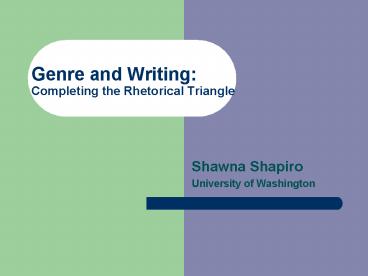Genre and Writing: Completing the Rhetorical Triangle - PowerPoint PPT Presentation
1 / 16
Title:
Genre and Writing: Completing the Rhetorical Triangle
Description:
'Every communication is essentially a trilateral relationship. ... To incorporate theory and 'best practices' from both domains (language ... – PowerPoint PPT presentation
Number of Views:187
Avg rating:3.0/5.0
Title: Genre and Writing: Completing the Rhetorical Triangle
1
Genre and Writing Completing the Rhetorical
Triangle
- Shawna Shapiro
- University of Washington
2
Overall aims of this presentation
- To introduce ESL writing teachers to the aspects
of genre theory most applicable to their teaching
practice - To demonstrate ways in which genre analysis can
be incorporated into instruction
3
Presentation Outline
- Overlap between genre and L2 writing theory
- Most relevant principles of genre
- 3. Application of genre theory to the L2
classroom - 4. Discussion
4
The Rhetorical Triangle
- Every communication is essentially a trilateral
relationship. Each point of the triangle
influences the others, and all are influenced by
the context of the communication. Each point of
the triangle bears some responsibility for the
success of the communication. http//departments.
bloomu.edu/english/111rhettri.htm
5
Current Challenges in L2 Writing
Instruction
- To incorporate theory and best practices from
both domains (language acquisition and
composition) - To develop a paradigm that addresses both
textual and contextual aspects of writing - To continue to reflect student-centeredness and
pragmatism
6
Benefits of a Genre-based Instructional Paradigm
- Integrates reading and writing
- Unites text and context
- - Examines socio-cultural factors, as well as
discourse features - Incorporates both form and flexibility
- Allows for increased explicitness and
articulation of expectations - Promotes informed, empowered decision-making
- Offers transferable strategies
- - Skills that can be used in many
situations, rather than tasks that have been
tailored for one class
7
Container Model
- Container Model
- Genre was seen as a categorical container
holding certain types of texts
- Academic Genres
- five-paragraph theme
- autobiographical essay
- short story
- laboratory report
- Etc.
- Professional Genres
- resume
- meeting notes
- memo
- project proposal
- Etc.
8
Socio-Cultural Model
- Alternative to the container model
- The Socio-Cultural Model
- Genres constantly change
- Genres are not homogenous
- Genres reveal valuable information about
communities - Genres can be learned, but also modified and
adapted
9
Socio-Cultural Model (contd)
- Like archeological artifacts, genres teach us
about cultures and communities. - In addition, like tools, they allow us entrance
into those communities. - In other words
- Texts can help us understand, enter, and even
alter communities
10
Socio-Cultural Model (contd)
- Genres are active and dynamic, like organisms,
- Like members of biological ecosystems, genres
affect and are affected by the social and textual
systems (large and small) surrounding them.
11
Genre and L2 Writing
- Characteristics of genre-based writing
instruction (both L1 and L2) - Incorporates critical reading, exploring purpose,
audience, etc. - Notices features of texts content, format, word
choice, syntax, grammar, etc - (may use Discourse Analysis techniques, or other
sets of linguistic and sociolinguistic features) - Compares and connects genres (avoids isolation)
- Discusses values and beliefs as reflected through
writing - Encourages students to make informed choices
based on genre knowledge - May involve social studies and other
disciplines to add to students contextual
knowledge
12
Sample Lesson Letter to the Editor (A)
Genre and L2 Writing
- Objectives
- Students practice persuasive writing,
particularly through a problem-solution framework - Students understand context for periodicals and
editorial writing - Students practice analysis of audience
expectations through analysis of content,
organization, word choice, syntax, and
grammatical features.
13
Sample Lesson Letter to the Editor (B)
Genre and L2 Writing
14
Sample Lesson Letter to the Editor (C)
Genre and L2 Writing
15
Other Genre Analysis Ideas
- Transforming writing from one genre to another.
- (Eg expository essay gtgt brochure
contrastive essay gtgt letters (or dialogue)
between authors. - Comparing common academic genres (abstracts,
proposals, textbook introductions) across
disciplines to understand differences (especially
between humanities and natural sciences). - Using non-academic genres (advertisements,
restaurant menus, movie reviews, advice columns)
as a source of information about culture and
society. - Analyzing genres more familiar to students than
instructors (Instant Messaging, rap, blog, how
to manual)
16
For more information
- Email shapis_at_u.washington.edu
- My course websites
- www.staff.washington.edu/shapis/101a (L2)
- www.staff.washington.edu/shapis/131f (L1)
- Recommended reading
- C. Berkenkotter and T. Huckin (genres in
disciplines) - Suresh Canagarajah (current TQ editor,
sociocultural focus) - Ken Hyland (theory gtgt practice)
- Ann Johns (research gtgt practice and curriculum)
- John Swales (theory)
- William Grabe (theory)































